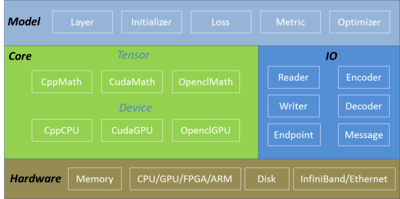Apache SINGA
 | |
| Developer(s) | Apache Software Foundation |
|---|---|
| Initial release | October 8, 2015 |
| Stable release |
1.1.0
/ February 12, 2017 |
| Development status | Active |
| Written in | C++, Python, Java |
| Operating system | Linux, Mac OS, Windows |
| License | Apache License 2.0 |
| Website |
singa |
SINGA is an Apache Incubating project for developing an open source machine learning library. It provides a flexible architecture for scalable distributed training, is extensible to run over a wide range of hardware, and has a focus on health-care applications.
History
The SINGA project was initiated by the DB System Group at National University of Singapore in 2014. It focused on distributed deep learning by partitioning the model and data onto nodes in a cluster and parallelize the training.[1][2] The prototype was accepted by Apache Incubator in March 2015. Five versions have been released as shown in the following table. Since V1.0, SINGA is general to support traditional machine learning models such as logistic regression. Companies like NetEase[3] and Shentilium are using SINGA for their applications.
| Version | Original release date | Latest version | Release date | |
|---|---|---|---|---|
| 1.1.0 | 2017-02-12 | 1.1.0 | 2017-02-12 | |
| 1.0.0 | 2016-09-08 | 1.0.0 | 2016-09-08 | |
| 0.3.0 | 2016-04-20 | 0.1.0 | 2016-04-20 | |
| 0.2.0 | 2016-01-14 | 0.2.0 | 2016-01-14 | |
| 0.1.0 | 2015-10-08 | 0.1.0 | 2015-10-08 | |
| Legend: Old version Older version, still supported Latest version Latest preview version | ||||
Software Stack
SINGA's software stack includes three major components, namely, core, IO and model. The following figure illustrates these components together with the hardware. The core component provides memory management and tensor operations; IO has classes for reading (and writing) data from (to) disk and network; The model component provides data structures and algorithms for machine learning models, e.g., layers for neural network models, optimizers/initializer/metric/loss for general machine learning models.

See also
References
- ↑ Ooi, Beng Chin; Tan, Kian-Lee; Sheng, Wang; Wang, Wei; Cai, Qingchao; Chen, Gang; Gao, Jinyang; Luo, Zhaojing; Tung, Anthony K. H.; Wang, Yuan; Xie, Zhongle; Zhang, Meihui; Zheng, Kaiping (2015). "SINGA: A distributed deep learning platform" (PDF). ACM Multimedia. doi:10.1145/2733373.2807410. Retrieved 8 September 2016.
- ↑ Wei, Wang; Chen, Gang; Anh Dinh, Tien Tuan; Gao, Jinyang; Ooi, Beng Chin; Tan, Kian-Lee; Sheng, Wang (2015). "SINGA: putting deep learning in the hands of multimedia users" (PDF). ACM Multimedia. doi:10.1145/2733373.2806232. Retrieved 8 September 2016.
- ↑ 网易. "网易携手Apache SINGA角逐人工智能新战场_网易科技". tech.163.com. Retrieved 2017-06-03.
.svg.png)